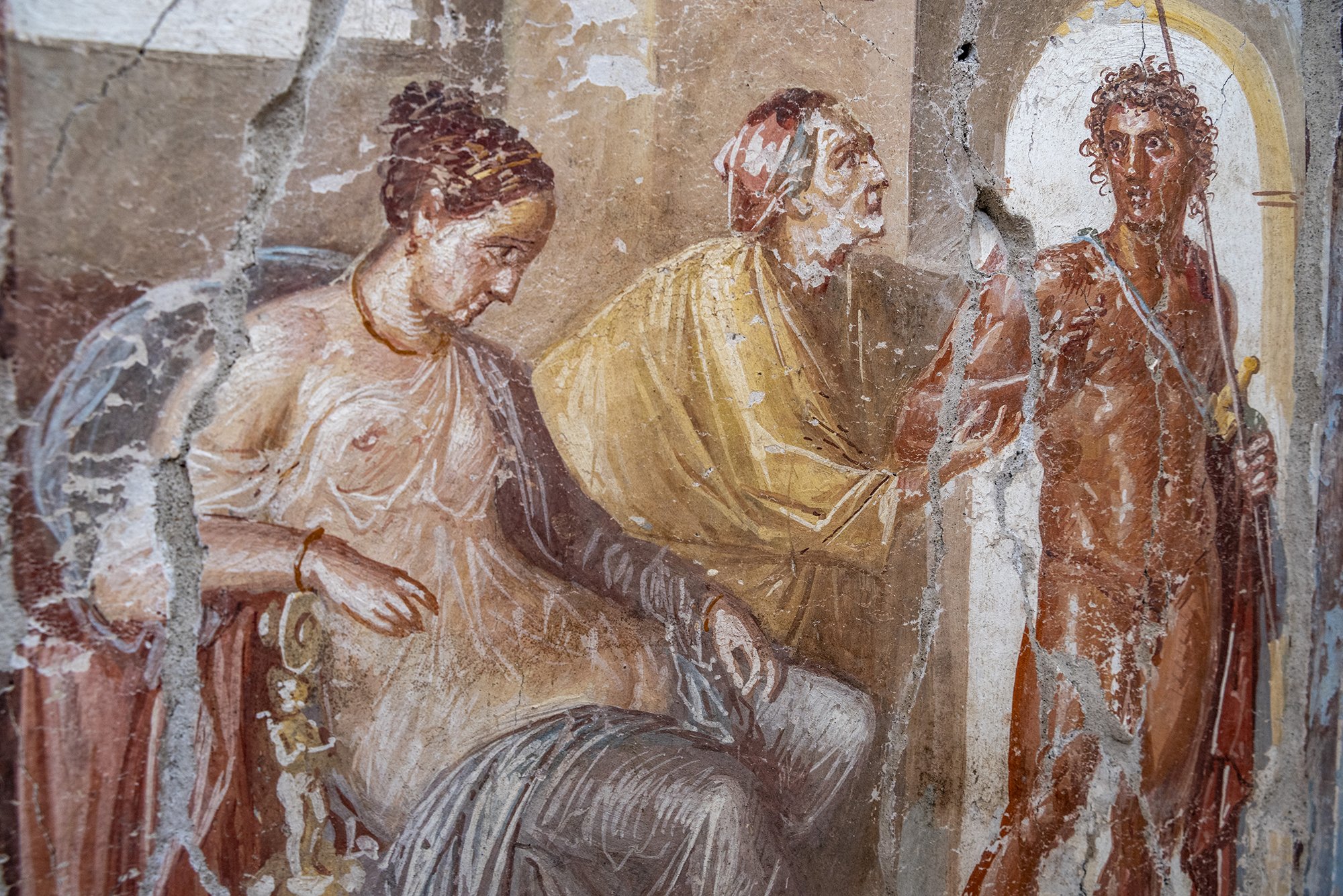
When we think of the murals in domestic spaces in Pompeii, we typically think of extravagant banqueting rooms or lavish columned atriums. But researchers have concluded that even “tiny houses” in the ancient city would have been richly decorated with frescoes.
The discovery came during excavations underway in the central district of Pompeii at the Insula dei casti Amanti construction site. Digging has been underway on the site of the ancient city for over 600 years, with new archaeological finds hitting the headlines regularly. Pompeii was engulfed in volcanic ash in 79 C.E. after the eruption of Mount Vesuvius, and the fallen ash that encased the city is believed to be responsible for the excellent preservation of its ruins.
A half-excavated fresco in the central region of Pompeii (2024). Image courtesy of Archaeological Park of Pompeii.
Archaeologists on site have found small homes—classified as those without a traditional atrium—featuring extensive wall murals during their investigations in central Pompeii along Via dell’Abbondanza.
The atrium was an open courtyard at the entrance of a home, enclosed by columns and small rooms. Atriums acted as a reception space, where the heads of households would take meetings and where certain ceremonies would be undertaken. The courtyard would also contain an impluvium—a basin for collecting rainwater which would have served a decorative as well as functional purpose. Atriums were a key feature of grand homes and were a marker of wealth in ancient Rome. But researchers are now finding that being atrium-less did not rule out ancient Pompeiians from decorating their homes lavishly.
One small home found to contain frescos which rivaled even its most wealthy neighbors is being provisionally named the House of Phaedra after an excellently-preserved fresco showing a scene from the ancient myth of Hippolytus and Phaedra. Other scenes painted onto the walls of the rear part of the House of Phaedra include an embrace between a nymph and a satyr, a couple thought to be Venus and Adonis, and a damaged mural showing the Judgement of Paris.
Murals in the rear rooms of the House of Phaedra (2024). Image courtesy of Archaeological Park of Pompeii.
The house also had a painted domestic altar at its entrance, decorated with birds of prey, sparrows, snakes, and plant motifs. Found inside the altar were a ceramic incense burner— complete with the remains of scented sprigs—and a lamp, both ceremonial objects.
The House of Phaedra is believed to have been undergoing construction work at the time of the 79 C.E. eruption.
Based on the discoveries made in the House of Phaedra, archaeologists are concluding that the presence of an atrium was not the be all and end all for Pompeiians displaying their wealth, and even those living in homes without one would go to lengths to demonstrate their tastes and showcase their belongings and furnishings.
The Insula dei casti amanti construction site is in varying levels of completion, with raised walkways built to allow visitors to access some of the areas in which excavations have been concluded. The Italian journalist and palaeontologist Alberto Angela recently produced a filmed report about the Insula dei Casti Amanti excavations, which will be broadcast on Italian television on Saturday, October 26.
Excavated altar in the House of Phaedra (2024). Image courtesy of Archaeological Park of Pompeii.
Gabriel Zuchtriegel, the Director of the archaeological park has said that the discovery—and how Pompeii’s archaeologists share their finds through their online platform—is key for the public understanding of archaeology: “If the construction site of the metro or a road is delayed due to archaeological finds, visiting Pompeii and observing the work of archaeologists and restorers can help us understand why it is worth documenting and safeguarding the traces of the generations who lived before us.”
He called the discovery an example of what he calls “circular archaeology”—a “virtuous circuit” involving “conservation, research, management, accessibility.”